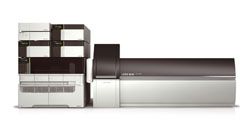The world's fastest LCMS/MS tandem mass spectrometer
Shimadzu has introduced the LCMS-8040 which combines newly improved ion optics and collision cell technology with proprietary ultrafast technologies. This significantly expands the application range and ensures high-sensitivity, high-throughput analysis at lower levels of detection.

Expanded range of ultra-fast, high-sensitivity applications
Shimadzu has introduced the LCMS-8040 which combines newly improved ion optics and collision cell technology with proprietary ultrafast technologies. This significantly expands the application range and ensures high-sensitivity, high-throughput analysis at lower levels of detection.
A five-fold increase in sensitivity (reserpine, S/N ratio) has been achieved in comparison to the LCMS-8030 model by improving ion focusing and minimizing ion losses between multi-pole lenses.
The fastest scan speed of 15,000 u/s and the fastest polarity switching time of 15 msec, already known from the LCMS-8030, expand in combination with the higher sensitivity the potential range of LC/MS/MS applications. The LCMS-8040 achieves multiple reaction monitoring (MRM) transition speeds of up to 555 MRMs per second utilizing UFsweeper II collision cell technology. UFsweeper II features high-speed ion transport technology that maintains sensitivity and suppresses crosstalk, even for high-speed or simultaneous multi-component analyses.
LabSolutions LCMS software offers a variety of data processing features, including a Quantitation Browser which processes multiple analytes, and a Data Browser which allows users to analyze and compare multiple sets of data in the same window.
For more information please visit ref="http://www.shimadzu.eu">www.shimadzu.eu
Thermodynamic Insights into Organic Solvent Extraction for Chemical Analysis of Medical Devices
April 16th 2025A new study, published by a researcher from Chemical Characterization Solutions in Minnesota, explored a new approach for sample preparation for the chemical characterization of medical devices.
Sorbonne Researchers Develop Miniaturized GC Detector for VOC Analysis
April 16th 2025A team of scientists from the Paris university developed and optimized MAVERIC, a miniaturized and autonomous gas chromatography (GC) system coupled to a nano-gravimetric detector (NGD) based on a NEMS (nano-electromechanical-system) resonator.
Miniaturized GC–MS Method for BVOC Analysis of Spanish Trees
April 16th 2025University of Valladolid scientists used a miniaturized method for analyzing biogenic volatile organic compounds (BVOCs) emitted by tree species, using headspace solid-phase microextraction coupled with gas chromatography and quadrupole time-of-flight mass spectrometry (HS-SPME-GC–QTOF-MS) has been developed.
A Guide to (U)HPLC Column Selection for Protein Analysis
April 16th 2025Analytical scientists are faced with the task of finding the right column from an almost unmanageable range of products. This paper focuses on columns that enable protein analysis under native conditions through size exclusion, hydrophobic interaction, and ion exchange chromatography. It will highlight the different column characteristics—pore size, particle size, base matrices, column dimensions, ligands—and which questions will help decide which columns to use.





